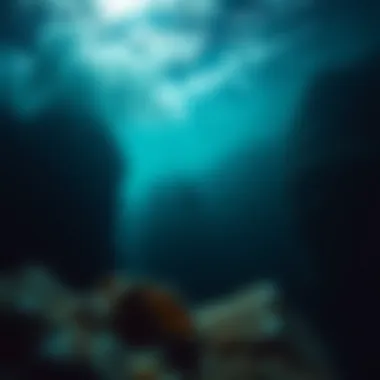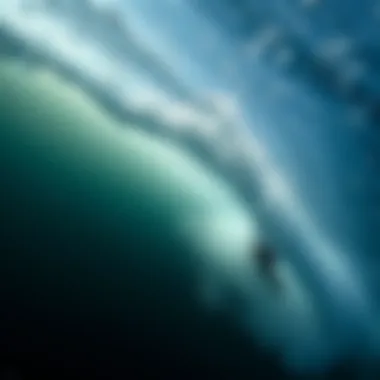Exploring the Ocean: Insights into Diverse Ecosystems


Intro
The vastness of the ocean is like an open book, filled with stories yet untold. Covering more than 70% of our planet’s surface, it plays a crucial role in everything from weather patterns to marine life. But to many, the ocean remains a mystery. As we dive into its depths, we’re not just exploring the physical aspect of the water; we're also uncovering a world where ecosystems thrive, where surf culture finds its roots, and where our responsibility for environmental stewardship beams bright.
The ocean isn’t merely a backdrop for our leisurely activities. It’s a living entity that influences climate, nourishes life, and shapes economies. For surfers, it’s a passion; for scientists, it’s a subject of rigorous study. The connection is profound, and understanding these dynamics can enrich our appreciation for both the ocean and our interactions with it. From the tiniest plankton to the majestic blue whale, each element contributes to a balance that sustains life on Earth.
As we journey through this article, we will peel back layers to reveal the inner workings of the ocean, its rich biodiversity, and the intricate ties it shares with humanity. We'll discuss how the ocean impacts global climates and dive into the lifestyle and technique of surfing—a sport that beautifully intertwines with this aquatic world. This narrative is not just a collection of facts; it’s a call to recognize and respect what the ocean offers.
So, grab your board or simply sit back, and prepare to navigate through the remarkable insights into the ocean that will leave you inspired.
Surfing Techniques
Beginner Tips for Getting Started
For those new to the exhilarating world of surfing, the first taste of riding a wave can be both thrilling and intimidating. Here are some essential tips to help you catch your first wave:
- Choose a Suitable Location: Look for spots with gentle, rolling waves, especially beaches that cater to beginners. Reading tide charts can also enhance your surfing outcomes.
- Get the Right Gear: A soft-top surfboard is ideal for novices. They are more forgiving and help build confidence.
- Learn to Paddle: Strength in paddling is fundamental. Practice lying on your board and paddling to understand the balance.
- Stay Calm: Breathe and remain calm when you fall—it's part of the learning!
Advanced Maneuvers and Tricks
Once you’ve mastered the basics, stepping up your game can be exciting. Here are a few advanced techniques to elevate your surfing experience:
- Bottom Turn: The bottom turn is a key maneuver. It sets you up for everything that follows. Carve hard into the wave and rise with the swell to generate speed.
- Cutbacks: This move helps you change direction while riding. As you approach the wave’s top, lean in and shift weight to pivot back toward the wave's face.
- Aerials: Mastering aerials involves speed and commitment. Approach the wave with momentum, launch yourself into the air, and control your landing upon returning to the wave.
The ocean teaches us resilience; every fall is merely a step towards mastery.
Surfboard Selection
Choosing the Right Board for Your Style
Selecting a surfboard should align with your abilities and goals. Different boards offer distinct experiences:
- Shortboards: Ideal for experienced surfers; they allow for quick maneuvers and high-speed turns but require skill.
- Longboards: Perfect for beginners and those who enjoy a relaxed ride; they provide stability and ease.
- Fish Boards: These are versatile, working well for all skill levels, and are favored in smaller waves.
Surfboard Maintenance and Care
A well-maintained surfboard enhances performance and lifespan:
- Clean Regularly: Rinse your board after every surf to remove saltwater and sand.
- Store Properly: Keep it out of direct sunlight to prevent damage. Use a board bag for transport.
- Inspect for Damage: Regularly check for dings and repairs to ensure your board remains in top shape.
To fully immerse oneself in understanding the ocean and the surfing life, one must recognize the interdependence of various elements, from board selection to the waves themselves. As we progress, each facet offers deeper insights into our aquatic adventures. Keep learning and growing with every tide.
The Ocean: An Overview
The ocean, covering more than 70% of the Earth's surface, is a vast body of water that influences not just climatic patterns but also the very existence of life. This section aims to establish a foundational understanding of the ocean's immense importance, not just environmentally but in a cultural sense. For every surfer riding the waves, every traveler exploring coastal regions, and every fitness professional advising on aquatic activities, the ocean holds a world of insights worthy of exploration.
Defining the Ocean's Extent
When it comes to defining the ocean's extent, one can easily venture into the depths of its geographic and hydrologic variety. The ocean is commonly divided into five primary areas: the Atlantic, Pacific, Indian, Arctic, and Southern Oceans. Each has unique characteristics that contribute to the planet’s biosphere. For instance:
- Atlantic Ocean: Often characterized as the 'cultural ocean', it connects North America to Europe and marks trade routes essential for maritime travel.
- Pacific Ocean: The largest and deepest, known for its extensive marine biodiversity, it serves as a crucial player in the global climate system.
- Indian Ocean: This ocean has significance for regional weather patterns and monsoons affecting millions.
- Arctic and Southern Oceans: These polar regions are pivotal in regulating Earth’s temperature and possess unique ecosystems.
This definition alone illustrates how richly diverse and integral oceans are, not just as physical bodies of water but also in shaping life and cultures across the globe. Understanding these distinctions is vital for conservation efforts and appreciating marine resources.
The Ocean's Role in Earth's Systems
The ocean plays an influential role in regulating global climate systems. For example, oceanic currents act like a gigantic conveyor belt, moving warm water from the equator towards the poles while bringing colder water back down to the tropics. This process not only influences weather patterns but also affects sea levels, marine ecosystems, and even the health of coastal communities.
- Carbon Sink: The ocean excels at absorbing carbon dioxide, mitigating climate change effects. Yet, as carbon levels rise, oceans also face the threat of acidification, affecting marine life.
- Weather Influence: Hurricanes and storms get their energy from warm ocean waters. The El Niño and La Niña phenomena illustrate how intricately linked weather events are to oceanic conditions.
"The ocean is not just an entity but a complex network of interactions that impact every corner of our lives."
In summary, the ocean is not merely a backdrop to our earthly existence; it's a critical player in ensuring the planet remains hospitable. Understanding its expanse and role in Earth’s systems is paramount for everyone—from outdoor enthusiasts to community stakeholders—who rely on its bounty.
Marine Biodiversity: A Hidden Wealth
The vast stretches of our oceans are teeming with life, creating a tapestry of ecosystems that reflect the incredible adaptability of marine species. Understanding marine biodiversity doesn’t just pique the curiosity; it underscores the intricate web of life where every organism plays a pivotal role. The significance of marine biodiversity is multi-faceted: it supports human needs, underpins ecosystem functioning, and provides a rich source of inspiration for many fields including medicine and art. With every tide and wave, the ocean reveals its bounty, yet much remains unexplored.
Overview of Marine Species Diversity


Marine species diversity is astounding, with estimates suggesting that there are around 230,000 officially described species, and many more yet to be discovered. This vast diversity includes everything from the smallest plankton to the magnificent blue whale. The variability among species can be attributed to different habitats, such as coral reefs, deep-sea trenches, and the open ocean, each offering unique living conditions.
- Coral Reefs: Often termed the "rainforests of the sea" for their rich biodiversity, these ecosystems support an array of life, including thousands of species of fish, mollusks, and crustaceans. Corals themselves, which are colonies of tiny animals, provide structure and habitat for other marine creatures.
- Open Oceans: Though seemingly barren compared to reefs, the open ocean is home to a myriad of organisms. From microscopic phytoplankton, the foundation of the marine food web, to large migratory species like tuna and sharks, the life here is both complex and interconnected.
- Deep-Sea Life: The depths of the ocean harbor species that have adapted to extreme conditions, such as high pressure and low light. Creatures like the anglerfish and giant squid have evolved unique features that allow them to thrive in this dark, harsh environment.
The interplay among these diverse species is crucial. For instance, a decline in one species can ripple through the ecosystem, affecting food webs and availability of resources.
Unique Adaptations of Ocean Creatures
Adaptation is the name of the game in the ocean, where life has evolved in fascinating ways to meet the challenges of a fluid environment. Creatures have developed specialized traits that help them survive and interact within their habitat.
- Bioluminescent Organisms: Many deep-sea animals like jellyfish and certain types of shrimp possess the ability to produce light through chemical reactions. This adaptation is used for attracting prey, communication, and evasion from predators.
- Camouflage Techniques: Creatures such as the cuttlefish can change their skin color and texture to blend in with their surroundings. This is not only crucial for defense against predators but also plays a role in hunting techniques.
- Specialized Feeding Mechanisms: The baleen whale has developed large, filter-feeding structures that allow it to consume vast amounts of small organisms. Meanwhile, other species like the beak of a parrotfish is designed for scraping algae off rocks, showcasing the diverse dietary adaptations in marine ecosystems.
These adaptations underscore the remarkable ingenuity of marine life, allowing them to thrive in environments that can shift with the seasons or change due to human impact.
Coral Reefs: The Rainforests of the Sea
Coral reefs are among the most vibrant ecosystems on the planet, rich in both biodiversity and beauty. Tropical coral reefs occupy only about 1% of the ocean floor, yet they are home to a staggering amount of marine life. Here’s why they are so vital:
- Biodiversity Hotspot: They serve as the habitat for approximately 25% of all marine species. Fish, sea turtles, mollusks, and a plethora of invertebrates all depend on reefs for sustenance and protection.
- Economic Importance: Coral reefs provide benefits to local communities, from fishing resources to tourism opportunities. Many coastal economies rely heavily on reef systems, where snorkelers and divers contribute to income through eco-tourism.
- Climate Regulation: They also play a role in regulating coastal climates, protecting shorelines from erosion and buffering against storms.
However, coral reefs are under severe threat due to a myriad of factors, including climate change, ocean acidification, and pollution. Protecting these precious ecosystems is critical, not just for the species that inhabit them but for the well-being of humanity as a whole. The sad reality is that we risk losing these underwater gardens unless concerted efforts are made to restore and conserve them.
Understanding the rich marine biodiversity and the unique adaptations of creatures, as well as the critical role coral reefs play, is vital for anyone from surfers carving waves to travelers exploring coastal ecosystems. It’s not just about enjoyment in the water; it’s about fostering a deeper connection and responsibility towards these marine treasures.
Ocean Currents and Climate
Ocean currents are not just the sea's highways; they're the very lifelines of our planet's climate system. Understanding these currents is crucial as they influence weather patterns, regulate temperatures, and, ultimately, impact the lifestyle of all forms of life, including humans. Currents transport warm and cold water across vast distances, thereby affecting everything from regional climates to global weather systems. Anyone who enjoys the surf knows the importance of ocean currents; they create the conditions for those perfect waves. However, their significance extends far beyond recreation—they play a foundational role in defining climatic conditions.
How Currents Shape Weather Patterns
Imagine being in a massive stage where the ocean is the performer and the currents are its dancers, twirling and bending to create the grand spectacle of weather patterns. Ocean currents work like a complex conveyor belt, moving warm water toward the poles and cold water toward the equator. This dynamic not only influences marine life but also shapes atmospheric conditions.
When warm water rises into the atmosphere, it causes the air around it to warm up too. This process can generate stormy weather that may lead to tropical storms or even hurricanes. For example, the Gulf Stream—one of the most well-known ocean currents—warms the northeast coast of the United States, making winters milder compared to other regions at similar latitudes. Without these currents, places like the UK and Ireland would likely experience harsher winters.
The relationship between ocean currents and weather can be likened to the symbiotic relationship of surf and swell. Just as surfers study swells to catch the best waves, meteorologists study ocean currents to predict weather patterns.
"The ocean is a lively character that dances with the wind, and it's through these dance moves that we feel the impact on land."
The Impact of Ocean Temperatures on Climate
It's well-known that rising ocean temperatures are a red flag for climate change. But what's often overlooked is how these temperature changes ripple through our climate systems. When we discuss ocean temperatures, we're talking about the warmth of the water that influences everything from global heat distribution to sea-level rise.
For instance, when ocean waters heat up, they expand, contributing to rising sea levels. Additionally, warmer waters can lead to increased evaporation, affecting rainfall patterns. Regions that used to have steady rainfall might find themselves in a drought, while others may be flooded. This is particularly noticeable in places like the tropics, where warmer surface temperatures can intensify storms and rainfall.
Higher ocean temperatures also impact marine ecosystems. Coral reefs, which are sensitive to temperature changes, experience bleaching when waters are too warm. This not only devastates marine biodiversity but also has serious socio-economic implications for communities that rely on reefs for food and tourism.
Incorporating knowledge about ocean temperatures into our understanding of climate will allow outdoor enthusiasts, surfers, and policymakers to delve deeper into sustainable practices. The interconnection of ocean health and climate stability underlines the importance of ocean conservation efforts, ensuring that future generations can still enjoy the natural beauty and bounty the oceans provide.
By keeping an eye on ocean currents and temperatures, we can better predict the climate shifts that affect our weather patterns, economies, and lifestyles. This maritime knowledge is crucial for those who thrive at the edge of the surf, as well as for anyone with a vested interest in the delicate balance of our environment.
The Ocean Floor: A World Unseen
The ocean floor is like a hidden treasure chest, a vast realm that many have yet to truly explore. It's not just dark and mysterious; it serves as a critical component of our planet's ecosystem. Understanding its topography and unique features sheds light on how they influence not only marine life but also global climate patterns. From underwater mountains to expansive plains, the ocean floor is a world rich in biodiversity and geological activity, playing a vital role in ocean dynamics and, hence, our climate.
Topography of the Ocean Floor
The lay of the ocean floor is anything but flat. If you'd take a peek beneath the waves, you'd find a variety of landforms, much like what we see on land. Seamounts, for instance, are underwater mountains formed by volcanic activity rising tens of thousands of feet from the ocean floor. These structures create unique ecosystems that support a rich array of marine life, from tiny plankton to massive whales.
- Continental Shelves are the shallow areas that extend from land, where most fishing occurs and diverse life thrives.
- Abyssal Plains are the flat, deep ocean areas that cover more than half of the Earth's surface, teeming with unique organisms adapted to extreme conditions.
- Mid-Ocean Ridges are massive underwater mountain ranges formed by tectonic plates moving apart, marking the regions where new oceanic crust is born.
These varied geological features impact ocean currents and, in turn, climate. The uneven landscape creates pathways for water to move, influencing everything from nutrient distribution to temperature regulation.
Hydrothermal Vents and Underwater Mountains
Among the cheeky wonders of the ocean floor are hydrothermal vents. Imagine deep cracks in the Earth spewing superheated water, rich in minerals. These vents create habitats unlike any other, home to oxygen-free organisms that thrive in the harsh conditions. These life forms, like tube worms and certain bacteria, have peculiar adaptations to survive without sunlight.
Not far from these vents, you'll stumble upon underwater mountains—also known as seamounts. They aren’t just geological oddities; they're bustling hubs of marine biodiversity. Seamounts rise from the ocean floor, often serving as reservoirs of endemic species that aren’t found anywhere else on the planet. Coral formations around these underwater mountains play an integral role in maintaining healthy marine ecosystems.
"The ocean floor is not just a barren wasteland; it’s a thriving environment with hidden gems that can unlock secrets about the Earth’s history and our future."


As scientists push the boundaries of exploration, we realize how interconnected these underwater features are with our climate and marine life. In understanding the ocean floor, we also begin to grasp the implications for our broader ecological balance.
For more information on ocean floor exploration, resources like Wikipedia, Britannica, or the NOAA can provide a wealth of additional details.
Threats to Ocean Health
The ocean, often dubbed as the heart of our planet, is facing several grave threats. Understanding these dangers is vital, not just for marine life but for human existence too. Oceans cover about 71% of Earth’s surface, playing a crucial role in regulating climate, supporting biodiversity, and providing resources like food and recreation. However, these systems are now under siege from various forms of pollution and the relentless tide of climate change.
Pollution and Its Impacts
Pollution comes in various forms – plastic waste, chemicals, oil spills, and even noise pollution from ships. Each of these pollutants carries dire consequences for the health of ocean ecosystems. For example, plastic waste isn't just an eyesore; it breaks down into tiny particles known as microplastics, which can be ingested by marine life and eventually make their way into the human food chain.
Key impacts of pollution include:
- Marine life harm: Many fish and other marine creatures mistake plastics for food, leading to injury or death.
- Habitat destruction: Chemical runoff from agriculture can create dead zones with little to no oxygen, posing threats to life.
- Ecosystem imbalance: Oil spills can devastate marine habitats, resulting in long-term ecological damage.
Adverse effects from pollution have ripple effects beyond immediate areas. They often translate into health risks for coastal communities reliant on seafood. As these pollutants infiltrate everything from the plankton at the surface to the larger species that we catch, it's a clarion call for urgent action.
Climate Change and Ocean Acidification
Climate change remains an overarching threat to ocean health globally. Rising temperatures lead to warmer oceans, which can have far-reaching effects, including altering migration patterns for species and causing coral bleaching.
Ocean acidification is another significant concern, resulting from increased absorption of carbon dioxide by seawater. This phenomenon lowers the pH of ocean water, affecting the ability of marine organisms such as shellfish and coral to form their shells and skeletons. The repercussions are profound:
- Altered marine ecology: Species that cannot compete with acidification may disappear, leading to less biodiversity.
- Threatened food sources: Many coastal communities depend on shellfish for their livelihoods. As their populations dwindle, people are faced with economic troubles.
In essence, the threats to ocean health call for immediate and coordinated global action. As those who revel in oceanic pursuits—whether it's a surfer riding waves or a marine scientist studying ecosystems—our response is imperative.
"To protect the ocean is to protect our future. The health of our seas is intrinsically tied to the health of our planet and ourselves."
By recognizing these challenges and advocating sustainable practices, there lies potential for recovery and preservation of these essential waters.
Sustainable Practices for Ocean Conservation
The value of sustainable practices in ocean conservation cannot be overstated. As our oceans face ever-increasing threats, from climate change to pollution, it's crucial to adopt methods that not only protect marine ecosystems but also ensure they can thrive for future generations. Sustainable practices hold the key to tipping the scales back toward health and balance in these vast waters.
Importance of Marine Protected Areas
One of the foremost strategies in ocean conservation involves the establishment of Marine Protected Areas (MPAs). These regions are designated to safeguard vital marine habitats from destructive activities like overfishing and habitat degradation. The benefits of MPAs resonate beyond their borders, enhancing biodiversity and promoting resilience against changes brought on by climate shifts.
- Biodiversity Hotspots: MPAs serve as critical refuges for a myriad of species. They offer a safe haven for fishes, corals, and other organisms to flourish away from human interference. For example, the Great Barrier Reef Marine Park in Australia embodies how protection can lead to rebound effects, improving both ecological well-being and tourism revenue.
- Fisheries Management: By limiting access to certain areas, MPAs can help replenish fish stocks. This helps sustain the livelihoods of local fishing communities. When fish populations are allowed to recover, the benefits trickle down, supporting local economies.
- Scientific Research: MPAs also facilitate vital research opportunities, allowing scientists to study marine ecosystems in relative peace. Learning from these environments can lead to broader insights applicable to conservation strategies globally.
"Sustainable management of marine resources often results in healthier ecosystems, which in turn means greater resilience to external pressures."
Innovative Approaches to Fishing
Fishing, while a traditional practice, has seen advancements that align better with sustainability. Innovative approaches to fishing are vital to ensuring that fishing practices do not deplete ocean resources. Here are some noteworthy trends:
- Selective Fishing Techniques: Utilizing gear that targets specific species can significantly reduce bycatch. Devices like circle hooks and fish traps minimize the capture of unintended species, thus preserving broader marine life.
- Aquaculture Advancements: The rise of sustainable aquaculture—farming fish and other seafood—has been transformative. Technologies that include recirculating aquaculture systems can lessen environmental impacts while still providing a stable supply of seafood. For instance, land-based fish farms can reduce strain on wild populations, allowing ocean ecosystems to recover.
- Community-Based Management: Empowering local communities to manage their fishing resources has led to remarkable successes. When local populations have a stake in protecting their environment, they are more likely to engage in practices that promote sustainability. This approach allows for culturally relevant strategies that consider both economic needs and conservation goals.
Embracing these sustainable practices is not just about conservation; it’s about fostering a relationship with our oceans that respects their complexity and fragility. Every small step taken in sustainable practices helps pave the way toward healthier, more vibrant oceans, crucial for current and future generations.
Ocean Exploration: Pioneering the Unknown
Ocean exploration represents a crucial avenue for understanding our planet. The ocean covers about 71% of the Earth's surface and remains one of the last frontiers for scientific inquiry. Although significant advancements have been made in marine research, a large portion of the ocean remains uncharted. This section underscores the vital role of ocean exploration, emphasizing its contributions to marine science, environmental conservation, and even addressing global challenges like climate change.
The mysteries of the deep sea, brimming with unique ecosystems and species, offer a glimpse into biodiversity that is often overlooked. A better grasp of these underwater realms helps us appreciate the complexities of marine life and its interactions with human activity. Through exploration, scientists can gather valuable data to support conservation efforts, establish marine protected areas, and understand how to mitigate the effects of pollution and climate changes impacting these ecosystems.
Technological Advances in Oceanography
Technology has dramatically enhanced the capabilities of ocean exploration. Innovations in underwater drones, submersibles, and autonomous vehicles have transformed how we investigate marine environments. For instance, remotely operated vehicles (ROVs) now allow researchers to navigate extreme depths, capturing high-definition images of seafloor ecosystems.
Additionally, satellites equipped with advanced sensors monitor ocean temperatures and currents, offering insights that were once difficult to obtain. These tools not only make exploration more efficient but also reduce the costs associated with deep-sea research. Scientists can gather information from previously unreachable depths and analyze it quickly, demonstrating the technological leap we have made in understanding the oceans.
Furthermore, innovations such as sonar mapping and acoustic technologies provide detailed images of the ocean floor, which is essential for habitat protection and resource management. Being able to identify vital habitats, such as coral reefs or underwater volcanoes, helps prioritize efforts for conservation.
Significant Discoveries in Deep-Sea Research
Diving into the deep, scientists have made discoveries that challenge our understanding of biology and ecology. One significant finding is the existence of hydrothermal vents, where communities thrive in complete darkness, relying on chemosynthesis rather than photosynthesis. These unique ecosystems showcase life forms that thrive under extreme conditions, offering clues to the potential for life on other planets.


Yet, it's not just alien worlds that these discoveries hint at; they also inform us about Earth's past. Findings related to ancient marine life forms have directly influenced theories of evolution and biodiversity. Such insights are making waves in both science and education, enabling a greater appreciation for the complexity of marine ecosystems.
Moreover, the exploration has uncovered previously undocumented species, illustrating the ocean's vast biodiversity. Each of these discoveries not only fills gaps in taxonomy but raises new questions regarding conservation and environmental health.
"Many deep-sea species could hold keys to medical breakthroughs as they produce unique bioactive compounds."
The Cultural Significance of the Ocean
The ocean is more than just a body of water; it's a source of inspiration, spirituality, and identity for many cultures around the world. Its vastness and depths have captivated human imagination for centuries, serving as a backdrop for myths, religious beliefs, and creative expression. This section dives deeper into the cultural significance of the ocean, highlighting its multifaceted role in shaping societies and influencing cultural narratives.
Oceans in Mythology and Religion
From ancient civilizations to modern spiritual practices, the ocean has sown the seeds of countless stories and religious beliefs. Many cultures have viewed the ocean as a divine entity or a realm inhabited by powerful deities. For instance, in Greek mythology, Poseidon stands as a mighty god of the sea, wielding control over storms and earthquakes. Communities often paid homage to such deities, seeking their favor to ensure safe voyages or bountiful fishing.
Native American tribes, too, have rich traditions tied to the ocean. For instance, the coastal tribes of the Pacific Northwest view the sea as a provider, with stories honoring marine life like salmon. They use these narratives to pass down wisdom about sustainable practices, illustrating a deep respect for aquatic ecosystems.
In a different way, many Polynesian cultures woven the ocean into their identity. Navigators set out across vast expanses of water, using the stars and ocean currents for guidance. Their folklore reflects a profound relationship with the sea, portraying it as a living entity; not just a resource, but a teacher of resilience and community.
Impact on Art and Literature
The ocean has long been a muse for artists and writers, serving as a canvas for expressions of beauty, turmoil, and everything in between. In literature, authors like Herman Melville in Moby Dick explore existential themes, using the ocean as a backdrop for human struggle and pursuit. This narrative intertwines readers with the vastness of the ocean, provoking reflections about life's broader meaning.
Visual artists have also drawn inspiration from the ocean. Impressionist painters like Claude Monet captured the shifting tides and shimmering surfaces, inviting viewers to experience the sea's transient beauty.
Moreover, contemporary art often reflects the urgency of ocean conservation, showcasing the fragility of marine ecosystems. Installations and performances now aim to raise awareness about pollution and climate change effects, making the ocean a subject not only of admiration but also of advocacy.
In summary, the ocean resonates deeply across cultures, contributing to mythology, religion, art, and literature. It encapsulates a narrative that intertwines spirituality and creativity, reminding us of the ocean's essential role in human experience.
The ocean is not a barrier, but a bridge that connects us to our past, our culture, and each other.
Through understanding these cultural dimensions, we can foster a greater appreciation for the ocean, not just as a natural resource but as a profound source of human connection and creativity. As surfers, travelers, and outdoor enthusiasts engage with these waters, they partake in a legacy that touches the heart of humanity itself.
The Future of Our Oceans
As we stand on the brink of ecological upheaval, understanding the future of our oceans is not just vital but imperative. The health of oceans has direct implications for our existence; they regulate climate, support diverse life forms, and provide sustenance to millions. The changes we face — from rising temperatures to increased pollution — are signals that provoke immediate action. Awareness coupled with proactive measures will carve a path to sustain this vast blue resource that is intrinsic to our planet’s well-being.
Predictions and Challenges Ahead
In the upcoming decades, our oceans face a mixed bag of predictions and challenges. National Oceanic and Atmospheric Administration (NOAA) reports suggest that ocean temperatures will keep rising due to climate change, leading to widespread coral bleaching and altering habitats. Here are several noteworthy predictions:
- Rising sea levels will likely affect coastal communities. This forces cities to adapt or face inundation.
- The acidification of oceans will impact marine life, particularly organisms with calcium carbonate structures, like oysters and certain plankton, which are foundational to marine food webs.
- Changes in fish distribution due to temperature variations might disrupt fishing industries, impacting economies globally.
These challenges demand immediate responses. Failure to address them could lead to irrevocable damage. Initiatives that combine science with grassroots activism become paramount. Solutions should be tailored not only to mitigate harmful practices but also to harness community involvement in conservation efforts.
The Role of Communities and Organizations
Communities and organizations can be the unsung heroes in promoting ocean health. Grassroots movements have the potential to spark change from the bottom up. Here’s how they can step up:
- Education and Awareness: Local initiatives that teach the importance of ocean preservation help nurture informed communities. Citizen science programs can engage everyday people in data collection and monitoring projects.
- Local Conservation Projects: Beach clean-ups, habitat restoration, and activism against harmful practices not only aid the environment but foster a sense of responsibility and belonging within communities.
- Policy Advocacy: Nonprofits and advocacy groups can influence legislation by lobbying for marine protected areas and sustainable fishing practices. Their ability to mobilize public opinion is crucial.
To enjoy the ocean's wonders tomorrow, we must act carefully today.
For further information and resources on ocean conservation, visit: NOAA, Ocean Conservancy, and The Ocean Agency.
Engaging in conservation is not merely a call to action; it is a journey that must evolve with our understanding of the ocean's depths and mysteries.
Final Thoughts
The ocean, a vast and dynamic entity, encapsulates both beauty and complexity that resonates with surfers, travelers, and nature lovers. It is not just a resource for recreation or livelihood; it is an essential element of our existence and ecosystem. As we look towards the future, the health of our oceans directly influences not just marine life, but our climate, economies, and cultures. Understanding the intricate relationships between human activities and ocean health is crucial for fostering effective conservation strategies. This article provides an insight into these critical relationships, highlighting that awareness is merely the first step toward meaningful change.
Emphasizing the Need for Awareness
Much of the general populace remains uninformed about the depth of challenges facing our oceans. From the perils of pollution to the nuances of climate change, there exists a dire need to educate ourselves about oceanic issues. Awareness serves as a catalyst for action; it bridges ignorance with understanding. Consider the impact of plastic waste on marine life—every year, millions of tons of plastic end up in oceans, suffocating ecosystems and endangering species.
"When we grasp how our choices affect ocean health, we can make informed decisions that contribute to its well-being."
Initiatives like beach clean-ups or ocean conservation workshops go a long way in cultivating conscious behaviors. Keeping abreast of news articles about marine conservation or following reputable organizations on social media can enhance awareness. Supporting educational programs that reach schools and communities is also vital, as they nurture future stewards of the oceans.
Encouraging Personal Involvement in Conservation
Personal involvement in conservation effort is perhaps the most impactful way we can support ocean health. It’s one thing to understand the issues; it’s another to roll up your sleeves and make a difference. Take up local initiatives that address ocean cleanliness, or simply reduce your plastic consumption. Using reusable bags or containers isn’t just a trend; it’s a way of living that contributes directly to the health of marine ecosystems.
Engaging with local surf communities can also provide support for initiatives aimed at protecting our oceans. Participating in eco-friendly travel and supporting businesses that prioritize environmental health can extend beyond personal impact; it spans into collective movement.
It's imperative to remember that every small action counts. Whether you’re attending community events, lobbying for changes in policy, or simply sharing knowledge with others, each step leads us closer to healthier and more sustainable oceans. The future of our oceans rests in our hands, and together, we can journey toward a promising horizon.



